Drama in the bush
We visited the Selous again, our third trip there – it’s always interesting to see the differences between the seasons. In November and December it is supposed to rain in the Selous, and then in January the northern carmine bee-eaters migrate through in their hundreds. The bee-eaters follow cars to grab the insects straight from the air in their acrobatic show as the insects are disturbed when driving through the grass. We had come in the hope to see this spectacle.
This year however, there had been no rain in the Selous in November or December. When we approached in the little plane, we could already see how dry it was, brown dust everywhere instead of lush and green bush.
We landed and Zahor was there to pick us up again, our favourite driver with his eagle eyes. We cruised around, talking about the dry-ness of the Selous and realised that even though the bee-eaters were around, they weren’t interested in following the car as there were simply no insects. A few bee-eaters tried over the 2 days, but it wasn’t quite the show we had hoped for. We might have to try again next year!
The effect the drought had on the animals was easily visible. We saw several dead buffalo as they seem to have been hit particularly hard by the conditions. Close to one of the dead buffaloes was a single wild dog. Very odd. They normally hunt in packs of 15-20, making them one of the most successful hunters. We assumed his pack must be near, but they weren’t. He managed to kill a baby impala and eat the majority of it within just a few minutes. The poor mum was nearby and looked quite distressed.
Heading out a bit further we were driving across one of the now dry lakes. From a little distance we could already smell it – death. And as we rounded the corner we saw a horrific scene. The last mud pools were drying and poor animals trying to get to the remaining puddles of water were getting stuck in it. Several impalas had already died and the predators and scavengers were having a feast. But even more depressing were the 3 impalas still alive, occasionally trying to wrestle themselves free from this incredibly thick and gloopy mud. It was pointless. Only their heads and necks were visible, the rest had sunk as the poor animals kicked and fought to get out.
It was too heartbreaking to watch, so we decided we would try to rescue them. We quickly realised this was going to be a pretty tricky operation as we could hardly get close to them. Hard lumps of dried crust, rested on a gloopy, gassy and unstable muddy under-layer which was not quite dry yet. In effect you were walking on dry, but unstable tiny ‘islands’. This made for some interesting scenes as we tried to get close enough to pull the impalas out.
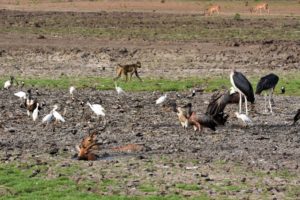
life and death go hand-in-hand – impalas stuck in the mud provide food for the many predators around
Jude and Robert, the trainee guide, were the lightest and managed to get next to the first male, who only had one horn. Robert pulled on the horn and Jude tried to get underneath his tummy to pull there, scooping out the mud from around him. That wasn’t working. So Robert just pulled on his horns towards the front which seemed to work. Very slowly, inch by inch, the poor impala emerged from the gloop. As soon as he had his legs partly out he started to kick and tried to run, immediately getting stuck again between the next clumps of dried up mud. So, unceremoniously he was carried by Zahor (our driver), Robert (trainee guide) and Haruan (our guide) to the car where the ground was solid. They laid him down, exhausted, where he rested for a few minutes before eventually jumping up and racing away to safety and freedom.

we start the rescue of the first impala, the earth looks solid but is far from it, underneath the thin, dry top is a gloopy mud bath and it is incredibly difficult to stand on it
In the mean time we had returned to the next male impala. This one was even further out in the mud and we tried a different tactic, a tow rope. We lassoed it around his head, but it went too far and ended up around his neck. We only wanted the rope around his horns otherwise it would suffocate with the tightening noose. The only way to reach him was to lay flat on the mud, Robert did an excellent job.

impala number 2 is too far away to stand around and we use the rope around its horns to pull him out, we can only get to him by laying flat on the dry top layer as it won’t support our weight
Pulling him out was easy, but just as we were about to grab him on the slightly more stable ground the rope came loose and the impala tried to run. And ended up straight in the mud puddle we had just extracted the first impala from. We pulled him out again by the horns as before and carried him to solid ground near the car.

as the impala tries to stand he immediately gets stuck in the mud again as his legs get trapped in between the dry bits, we end up carrying him to solid ground
As we were trying to clean up a bit this male impala also rested, totally exhausted. But after a few minutes it still wasn’t getting up. What was wrong? We prodded it gently on its bum, no reaction. Clapped our hands to try to spook it into getting up, no reaction. Then Jude had the bright idea to grab his hind legs and push them off the piece of wood they were laying on, that worked. Off he went, leaping into the approaching herd of buffalo, scaring them and sending them running everywhere. It was a great sight.
We turned to look at the small female, the last one alive and stuck in the mud. We couldn’t get to her. She was in the middle of the still quite wet area and with no horns to tie a rope around her, we didn’t know how to pull her out. We had to leave her. Rather depressed we left the area where the marabou storks, the sacred ibises, the monitor lizard, the crocodiles and the vultures had already resumed their feeding frenzy. They had just watched us from a short distance away as we were pulling their future meals out of the mud. We didn’t feel bad for them as already enough dead animals were laying around, plenty of food for them.
Later in the trip we also saw a baby wildebeest, with the drying umbilical cord still attached, being deserted by its mother. Standing in the shallows of a lake, it wouldn’t take long before the youngster will be taken by the crocs. It could barely stand, maybe it was just too weak to follow mum? We don’t know, but we do know it is heart-breaking and you just want to take them home…
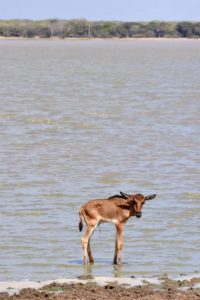
another drama, we spot this lone baby wildebeest on the shores of a lake, umbilical cord still attached means he is very young, but mum was nowhere to be found… crocs were already seen nearby and it probably won’t survive the day…
And to top it off, a goliath heron with a broken wing and a massive hippo dead, right in the middle of a croc infested and overloaded hippo mud pool. Add to that the several buffalo we saw dead in various location and it was clear that the Selous needs rain, and it needs it soon. There is water for those who know where to find it, but no grass to eat…
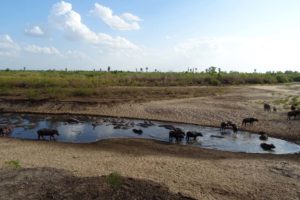
the few waterholes that are left are shared between many animals – crocs, hippos and buffalos are all mixed in here – can you spot the dead hippo?
Elephants, lions, impalas and a whole range of other animals can be found in Lake Manze camp at the moment as they have a small water hole which they keep topped up for the thirsty animals. We had several elephants pay us a visit, right up to the tent, and we had to wait a few times before we could get to or from our tent due to lions or elephants in the vicinity… It is lovely to have them so close, but also difficult as they munch their way around camp, removing the lovely shade!
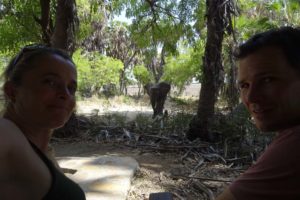
as the Selous was dry lots of elephants were browsing in and around the camp, including right in front and next to our tent
We thought that was enough drama for one weekend… we did have some amazing sightings, spotted some more new birds and enjoyed our conversations and dinner under the stars. We’re gonna do our own rain dance for Selous, maybe you can do one too!?
UPDATE: The good news is that by the time you read this blog, good rains have arrived right across Tanzania, including Selous. We have heard the lakes are filling up and hopefully the grasses will start growing soon too.

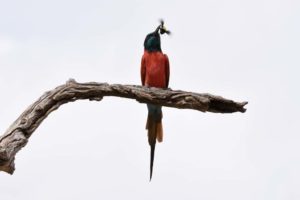

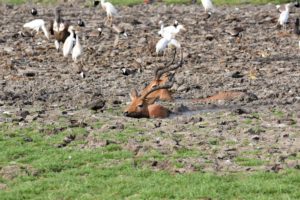

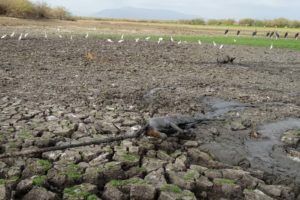
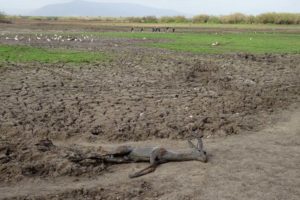
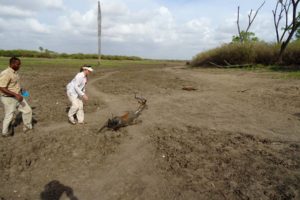
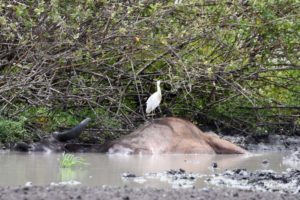


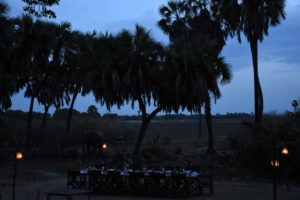
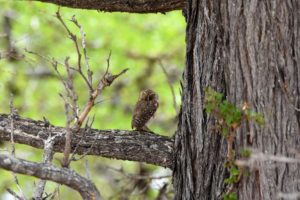
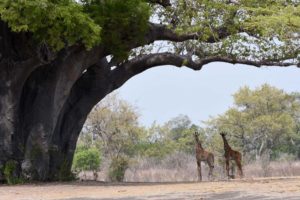
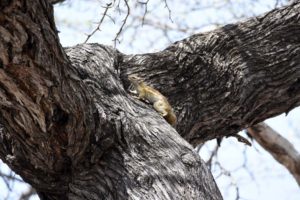

Hoi Judith en Jon, wat een belevenis om te allemaal mee te mogen maken. Kun je toch zien dat de natuur altijd zijn gang gaat. En dat ook de strekte dieren het overleven. Met ons gaat het zijn gangetje, hier en daar wat pijntjes . Stuur binnenkort wel een mail. Tot ziens over een paar weken. we horen wel wanneer je er bent. Veel lieve groetjes van ons xxxxxxxxxxxxxxx Flip en Ria
Ja, de natuur gaat altijd zijn gang, hoe ‘cruel’ het er soms ook uitziet… Ja, leuk! Zie je over een paar weken en sterkte nog met het helemaal beter worden! 🙂
How sad to see all the animals die! I am glad you could rescue at least two of them.
I know! It didn’t feel like we were helping much but all little bits count right?
Hi Jude en Jon,
Is mijn bericht wel doorgekomen??
ja!! maar ik moet alle comments ‘goedkeuren’. Dat is om te voorkomen dat mijn blog voor spam gebruikt wordt! 🙂 Meestal ‘approve’ ik een comment binnen een dag wel of zo…
👍👍
Hi Jude en John,
[Ik doe dit wel in mijn moers taal want het foutloze Engels van jou ben ik niet machtig!]
Weer een schitterend, boeiend verhaal vergezeld van schitterende foto’s. Heel erg fijn om te lezen. Zeker op een relaxte zondagmorgen met een lekkere kop A.H.- koffie.
Nu wel relaxt want we hebben een nare, emotionele tijd gelukkig heel goed en gelukkig weer gezond, kunnen afsluiten.
We zien uit naar je volgende verhaal! Tot die tijd, vanuit een bewolkt Oost Souburg, alle goeds en veel liefs voor jullie!
Theo en (nu nog lekker slapend!) Annie X!
Bedankt en dat mag altijd hoor, die moers taal spreek ik ook nog! 🙂 Ik heb het allemaal gehoord, fijn dat het weer helemaal goed is (hebben jullie mijn email nog ontvangen?) Heel veel liefs voor jullie terug, hopelijk zie ik jullie over een paar weekjes als ik weer in NL ben! Dikke knuffel! Jx
Het laatste: ja graag! We zullen de mail wel ontvangen hebben, maar in de massa is beantwoordener dus kennelijk erbij ingeschoten.
Nogmaals het allerbeste voor jullie en hopelijk tot spoedig ziens!
Th. X!
tot over een paar weken! Jx
Great rescue effort from wildlife warrior Jude! Glad to hear the rain has finally arrived. How nice you had Zahor again as your driver!
We have great memories of our trip to Selous! And if course Serengeti.
🙂 Yeah, they really needed the rain! And we specifically asked for Zahor again. He is such a great guy. Our lovely guide wasn’t there unfortunately (we asked for him too). It was another great weekend with more wild dogs, unbelievable! I still remember telling you there would be no chance of seeing those… hahahaha…